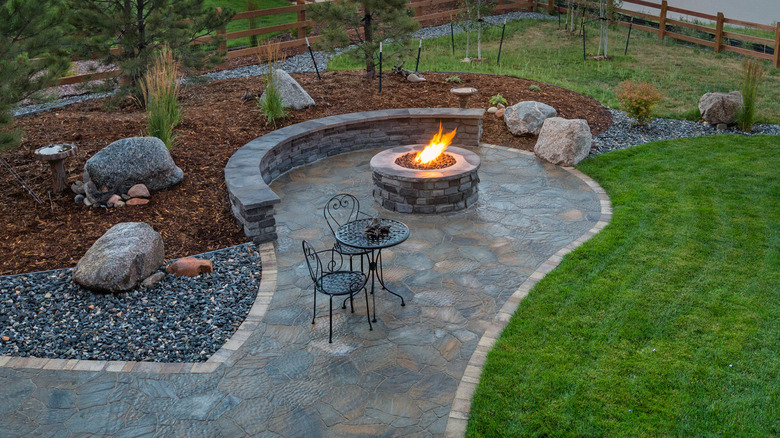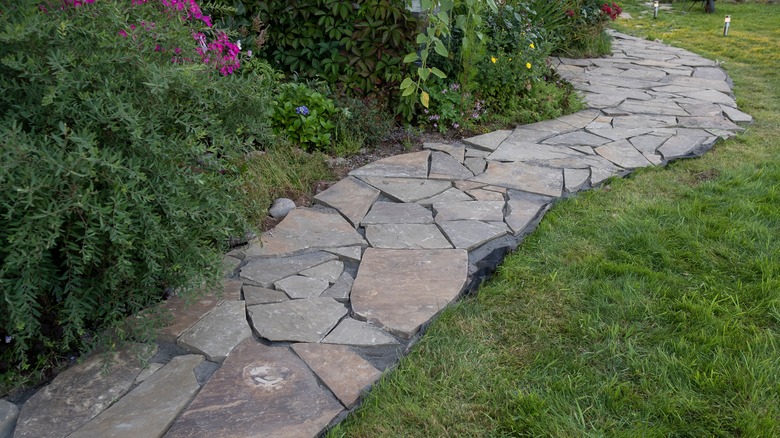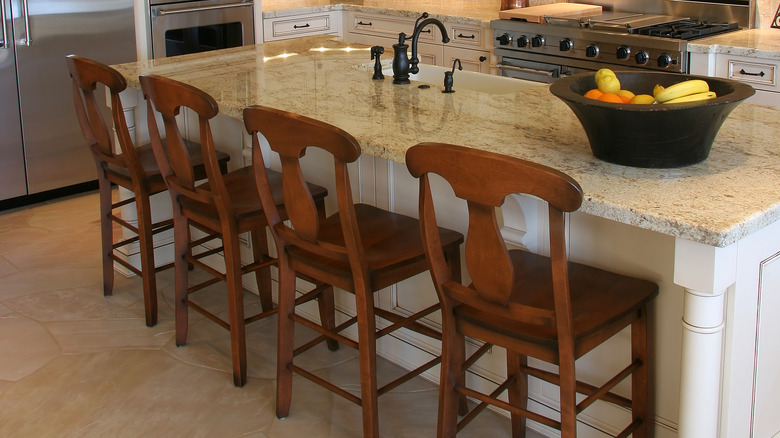Flagstone Paving Is Making A Comeback. Here's How To Make It Work In Your Space
Once used to line streets in New England cities, flagstone emerged in the coming decades and centuries as a popular material used in residential landscaping across the United States. Consisting of various forms of rock broken into smaller pieces by stonemasons, flagstone paving became a trend of choice for homeowners with pools, fire pits, and other outdoor spaces for entertainment. These additions grew especially popular in the country's southwestern region, as dry, arid climates led to residents turning to stone-centered landscaping trends that, unlike most domesticated plants, could thrive among harsh weather patterns. Flagstone paving has faded in and out of relevancy as trends come and go, though some argue the designs are timeless due to their versatility and ability to last for decades.
Flagstone is an expensive investment in your home's curb appeal, costing anywhere from $15 to $22 per square foot on average, including service costs and installation. So, it pays to weigh the pros and cons before adding the stone to your home's interior or exterior. Not only is flagstone pricey to install, but maintenance can also add another burden to homeowners since the stone can easily develop into a safety hazard or become aesthetically unappealing if not properly maintained over time. Here's a breakdown of the most common ways to incorporate flagstone into your indoor and outdoor style, along with how it's installed in the first place.
Outside your home
Flagstone is most commonly used to create walkways or designated entertaining spaces when installed outside a home. Since these slabs of rock need to support a decent amount of weight to serve their purpose, a proper foundation and base are necessary to ensure the safety of the guests and residents using these areas. Homeowners wanting to add pavers to their yards should understand that installation requires digging up portions of the ground to ensure the slabs remain in place. Contractors typically use sand or gravel as a base, considering both materials offer sturdy support that prevents weeds from springing up between stones.
Flagstone is typically available in two distinct styles: select and patio. These styles differ in size and thickness, with slabs of patio flagstone appearing thicker and smaller than select flagstone. Contractors normally use patio flagstones when designing walkways and patios in front or backyards. Though, the type of flagstone you install can depend upon the installation method of your project. Homeowners who choose a stronger base material, like mortar or cement, can get away with using thinner slabs of flagstone since these pieces have a stronger source of reinforcement lying underneath. Whether you want to hire a team to do the work for you or attempt to tackle the job yourself, consult a professional before getting started who can help choose materials to bring your vision to life safely.
Inside your home
Flagstone has also gained traction as an alternative to interior flooring, granting homeowners an escape from the more traditional hardwood and tile styles. Flagstone sheets used indoors are prepared quite similarly to flagstone installed outside. Like outdoor varieties, contractors apply a sealant on the installed stone slabs. This makes the surface smooth and easy to clean, like other types of hard flooring. Stone is naturally porous, so exposure to water can cause it to stain and erode. A sealant, or moisture barrier, is especially necessary inside a room like a bathroom, where the stone could face regular subjection to water and steam. Sealants may need to be applied as often as once a year to protect the stone underneath from destructive elements. Flagstone designs are also available in tile strip form, saving homeowners the hassle of fitting individual stones together jigsaw puzzle style.
Despite its infrequent appearance, flagstone floors can complement many different rooms of a home, including a sunroom, entryway or foyer, or even a kitchen, if appropriately color-matched with cabinets and countertops. If stone floors sound daunting or unappealing, flagstone can also be incorporated into your home in other ways. Crafting an accent wall inside a popular room of your house can be accomplished using flagstone, and flagstone fireplaces also make for a charming way to add a natural element to your home, indoors or outdoors.


